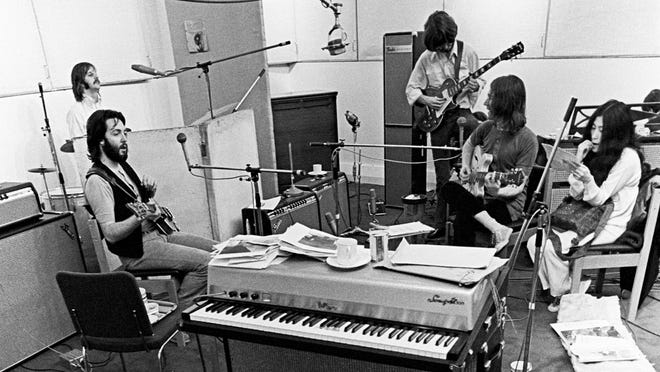
397945 14: Beatles albums are on sale at Tower Records November 30, 2001 in New York City. Former Beatle George Harrison died of cancer in Los Angeles November 29. (Photo by Mario Tama/Getty Images)
‘Get Back’ gives fans something more to love about The Beatles fifty years later
With The Beatles coming in at the top of WXPN’s listener-voted All Time Greatest Albums countdown with their classic Abbey Road, it gives us yet another reason to dive into the catalog of the pop / rock songwriting legends this winter.
Like many musicians and music enthusiasts in the world right now, I’ve been devouring the new Beatles documentary, Get Back. “Directed by Peter Jackson,” was a surprise. But why not commission the famed fantasy director to edit the music world’s most sacred documentary, an unbelievable 60 hours of studio footage of history’s most written-about band. No one can argue that Jackson knows how to direct epics, and that’s exactly how Get Back plays out: as a generously-edited, six hour documentary that has the power to rewrite history.
Get Back follows our heroes writing and rehearsing for their first live performance in years. At the beginning of January 1969, when the documentary opens, many aspects of the show are uncertain: the songs are unwritten, the venue is undecided, and even the band’s lineup is questioned. As The Beatles meet at Twickenham film studios (and later relocate to their Apple Studios), the only thing they know is that a live highly-anticipated and as-yet unannounced performance is looming.
It’s no secret that during the recording for 1969’s Let It Be, The Beatles were on the outs. The first thing I remember learning about Yoko Ono as a person and as an artist is that she was the so-called reason The Beatles split up. And there she is in most scenes of the documentary, sitting on John Lennon’s lap or stealing kisses between his vocal harmonies. But watching Get Back reveals even The Beatles themselves understood it would appear that way to the media — that Yoko drove a wedge between them — and how wholly untrue it was. In more than one scene, McCartney reads aloud to the group, with a mocking, doomsday tone, what the newspapers have just written about The Beatles. If scenes like this weren’t enough to convince audiences this group was on steady footing, you can see for yourself in the preceding hours-long footage.

Sure, George Harrison leaves the band after episode one, but the group’s conflict resolution skills could serve as a model for many instances of creative differences. Lennon and McCartney should’ve paid Harrison the respect he deserved, and the respect that history will show, but the fact that they recognized a power imbalance in the band felt like a momentous step. The women in the Beatles’ lives were also a far greater asset to the group than a hindrance. Linda Eastman, famous rock photographer and future Mrs. McCartney, makes many appearances — once with her young daughter Heather, who brings out the playful side of the Beatles’ personalities. Even the footage’s framing of McCartney’s character was positive. In all the hours of material, it’s not his bossy spat with Harrison that’s the most memorable. The benefit for McCartney and all the band members is that in the hours of downtime the film allows, each member’s personality unveils naturally. Starr’s humor, Lennon’s childish side, the way Harrison’s stoicism dissolved into wide smiles…all fit into the well-rounded perspective Jackson spliced together.
Getting to know The Beatles as the nuanced and flawed human beings they were makes the saga of Get Back and even more impressive. Pressured for time, it’s no wonder tensions were high. But these new glimpses into their relationship — Lennon ad-libbing voiceovers for McCartney’s songs, Ringo lighting Harrison’s cigarette, the band and management laughing in nervous excitement listening back to recordings — illustrate how magical the group’s dynamic really was. And the addition of keyboardist and longtime friend of The Beatles, Billy Preston — whose talent gave the band a run for their money — turned out to be the perfect way to ensure the founding members behaved themselves.
In hindsight, it’s painful to speculate on what could’ve been if only the internal conflicts had been resolved. If perhaps they had all taken some time away to explore writing solo, like Harrison explained he needed, and then reunited. Or if the band had been more weary of external threats, such as The Rolling Stones’ manager Allen Klein (who, if anyone is to blame for The Beatles’ demise, it’s this businessman). But as a fan of The Beatles, it’s more than enough to witness them, as honestly as can be captured on camera, at this vulnerable but creatively-explosive time.
It’s a gift that, after fifty years, Let It Be and the whole Beatles catalog can be listened to again with fresh ears.